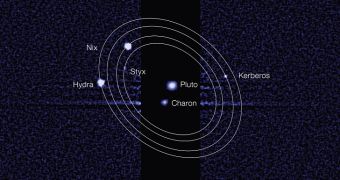Pluto may no longer be a planet, but it's still one of the more interesting objects in our solar system and certainly one of the objects we know the least about. One of the things that puzzled astronomers is the strange configuration of its moons.
Pluto's five satellites are arranged in a peculiar formation that astronomers have been struggling to explain. A new theory, by scientists at the Southwest Research Institute, suggests that a huge collision gave birth to the largest and closest moon, Charon, and a large number of smaller satellites.
In the aftermath of the collision, many of these satellites collided and changed places. In time, Charon's influence (the moon is about half the size of Pluto) made it that only the outermost satellites survived in their current form and stable orbits.
Styx, Nix, Kerberos, and Hydra, the small satellites beyond Charon, have orbital periods of three, four, five, and six times that of Charon. Previous models couldn't explain how the satellites could go so far out and not leave Pluto's influence or crash back down into Charon.
But early in the solar system's life, some four billion years ago, a great collision created the conditions necessary for the current satellites to form. But it wasn't a straightforward process; several generations of moons were created and then destroyed before these stable orbits were reached.

 14 DAY TRIAL //
14 DAY TRIAL //